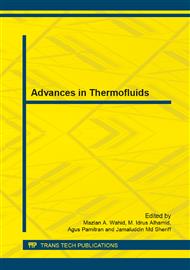[1]
H.A. Mohammed, G. Bhaskaran, N. H. Shuaib, R. Saidur, Heat transfer and fluid flow characteristics in microchannels heat exchanger using nanofluids: A review, Renew. Sust. Ener. Rev. 15 (2011) 1502-1512.
DOI: 10.1016/j.rser.2010.11.031
Google Scholar
[2]
H.A. Mohammed, A.A. Al-aswadi, N.H. Shuaib, R. Saidur, Convective heat transfer fluid flow study over a step using nanofluids: A review, Renew Sust. Ener. Rev15 (2011) 2921.
DOI: 10.1016/j.rser.2011.02.019
Google Scholar
[3]
K. V. Wong, and M. J. Castillo, Heat transfer mechanisms and clustering in nanofluids, Advance in Mechanical Engineering, 10 (2010) 1155-1164.
Google Scholar
[4]
S. Kakac and A. Pramuanjaroenkij, Review of convective heat transfer enhancement with nanofluids, Int J Heat Mass Transfer, 52 (2009) 3187-3196.
DOI: 10.1016/j.ijheatmasstransfer.2009.02.006
Google Scholar
[5]
Y. He, Y. Men, Y. Zhao, H. Lu, Y. Ding, Numerical investigation into the convective heat transfer of TiO2nanofluids flowing through a straight tube under the laminar flow conditions, Appl. Therm. Eng. 29 (2009) 1965-(1972).
DOI: 10.1016/j.applthermaleng.2008.09.020
Google Scholar
[6]
Y. Xuan and Q. Li, Heat Transfer enhancement of Nanofluids, International Journal of Heat and Fluid Flow, 21 (2000) 58-64.
DOI: 10.1016/s0142-727x(99)00067-3
Google Scholar
[7]
M.S. Liu, M.C. Lin, C.Y. Tsai, C.C. Wang, Enhancement of thermal conductivity with Cu for nanofluids using chemical reduction method, Int. J Heat Mass Transfer 49 (2006) 3028.
DOI: 10.1016/j.ijheatmasstransfer.2006.02.012
Google Scholar
[8]
Y.J. Hwang, Y.C. Ahn, H.S. Shin, C.G. Lee, G.T. Kim, H.S. Park, Investigation on characteristics of thermal conductivity enhancement of nanofluids, Current Applied Physical6 (2006) 1068-1071.
DOI: 10.1016/j.cap.2005.07.021
Google Scholar
[9]
I. Yılmaz, H. F. Öztop, Turbulence forced convection heat transfer over double forward facing step flow, Int Commun Heat Mass Transfer, 33 (2006) 508-517.
DOI: 10.1016/j.icheatmasstransfer.2005.08.015
Google Scholar
[10]
K. Chiba, R. lshida, K. Nakamura, Mechanism for entry flow instability through a forward-facing step channel, J. Non-Newtonian Fluid Mech, 57 (1995) 271-282.
DOI: 10.1016/0377-0257(94)01335-f
Google Scholar
[11]
M. Sabanca, Noise generated by turbulent flow over forward facing steps, Computers & Fluids, 38 (2009) 1467-1479.
DOI: 10.1016/j.compfluid.2008.01.019
Google Scholar
[12]
H. Stüer, A. Gyr,W. Kinzelbach, Laminar separation on a forward facing step, Eur. J. Mech. B/Fluids, 18 (1999) 675-692.
DOI: 10.1016/s0997-7546(99)00104-1
Google Scholar
[13]
H. I. Abu-Mulaweh, B. F. Armaly, T. S. Chen, Measurements in buoyancy-opposing laminar flow over a vertical forward-facing step, Int. J. Heat Mass Transfer39 (1996) 1805-1813.
DOI: 10.1016/0017-9310(95)00278-2
Google Scholar
[14]
M. Sherry, D. LoJacono, J. Sheridan, An experimental investigation of the recirculation zone formed downstream of a forward facing step, J. Wind Eng. 98 (2010) 888–894.
DOI: 10.1016/j.jweia.2010.09.003
Google Scholar
[15]
H. Iwai, K. Nakabe, K. Suzuki, K. Matsubara, The effects of duct inclination angle on laminar mixed convective flows over a backward-facing step, Int J Heat Mass Transfer, 43 (2000) 473-485.
DOI: 10.1016/s0017-9310(99)00141-6
Google Scholar
[16]
H. A. Mohammed, A. A. Al-aswadi, H. I. Abu-Mulaweh, N.H. Shuaib, Influence of nanofluids on mixed convective heat transfer over a horizontal backward facing step, Heat Transfer Asian Res. 27 (2011) 480-495.
DOI: 10.1002/htj.20344
Google Scholar
[17]
A. Kumar, A. K. Dhiman, Effect of a circular cylinder on separated forced convection at a backward facing step, Int J Therm Sci 52 (2012) 176-185.
DOI: 10.1016/j.ijthermalsci.2011.09.014
Google Scholar
[18]
R. S. Vajjha, D.K. Das, D.P. Kulkarni, Development of new correlations for convective heat transfer and friction factor in turbulent regime for nanofluids, Int J Heat Mass Transfer 53 (2010) 4607-4618.
DOI: 10.1016/j.ijheatmasstransfer.2010.06.032
Google Scholar
[19]
R. Chein, J. Chuang, Experimental microchannel heat sink performance studies using nanofluids, Int J Therm Sci 46 (2007) 57-66.
DOI: 10.1016/j.ijthermalsci.2006.03.009
Google Scholar
[20]
A. A. Al-aswadi, H.A. Mohammed, N.H. Shuaib, A. Campo, Laminar forced convection flow over a backward facing step using nanofluid, Int Commun Heat Mass Transfer 37 (2010) 950-957.
DOI: 10.1016/j.icheatmasstransfer.2010.06.007
Google Scholar


